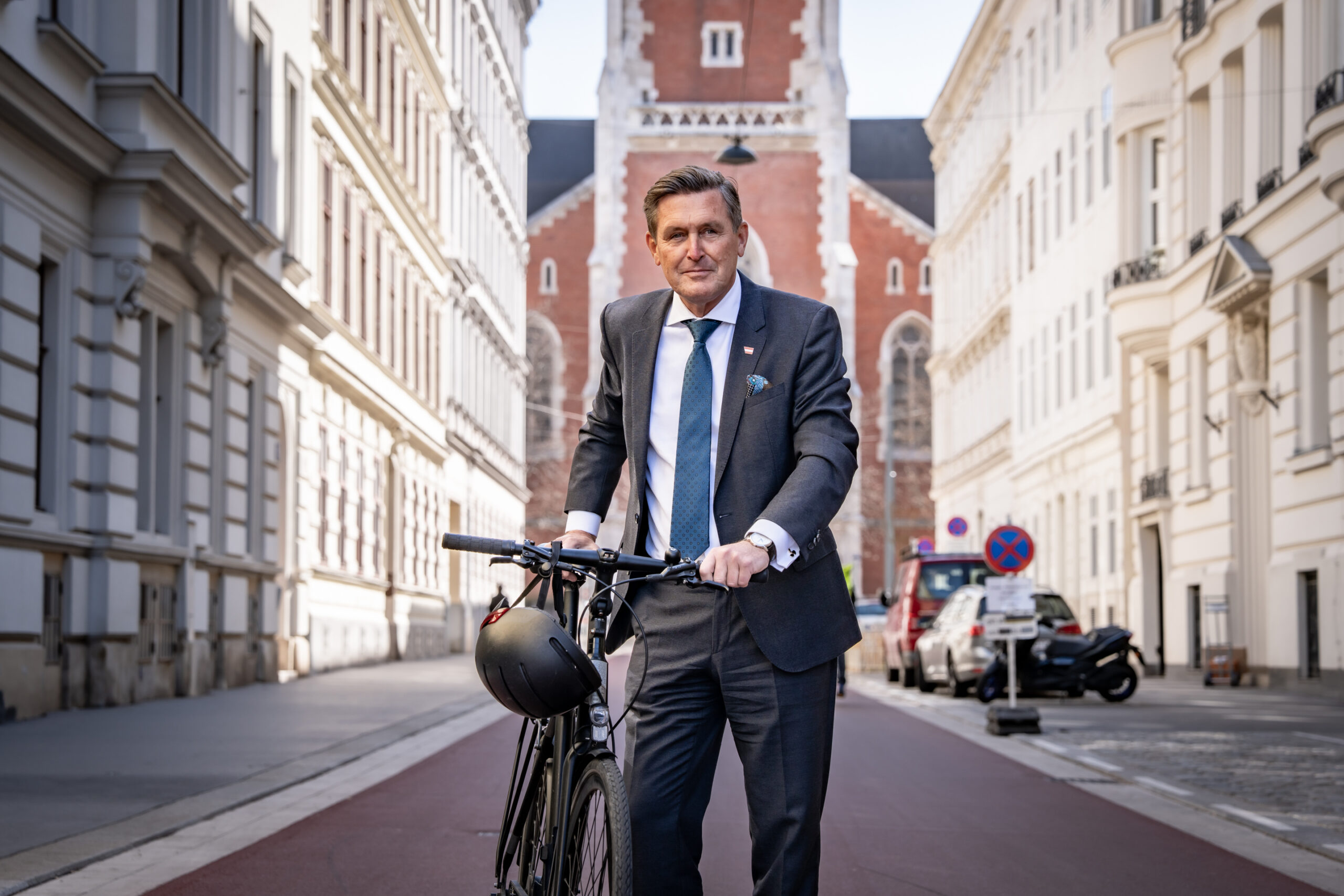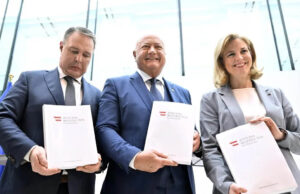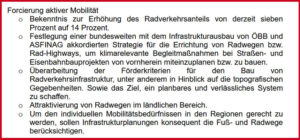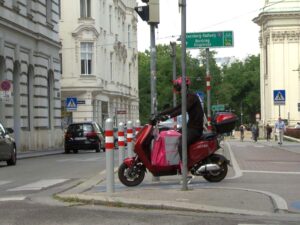What does Austria’s government programme promise for cycling?

The new federal government’s work programme contains important elements of Austria’s cycling strategy. The government wants to increase the cycling mode share to 14 per cent and has named some important measures to achieve this, the implementation of which is now up to the new Transport Minister Peter Hanke (SPÖ). We have taken a look at the most important points of the programme and provide assessments from Radlobby, a member of Cycle Competence.
Doubling the cycling mode share to 14 per cent
Around 160 days after the National Council elections, the new government presented itself in parliament on 27 February 2025. Included: a 211-page work programme called ‘Doing the right thing now’, which Federal Chancellor Christian Stocker (ÖVP), Vice-Chancellor Andreas Babler (SPÖ) and Foreign Minister Beate Meinl-Reisinger (Neos) were able to agree on behalf of their parties.
The most important message for cycling is on page 169: a commitment to increasing the cycling mode share from the current seven per cent to 14 per cent. Previously, an increase in the cycling mode share to 13 per cent by 2025 was agreed at federal level in accordance with the ‘Cycling Masterplan 2015-2025’. With a cycling mode share of 14%, the government programme has set itself a slightly higher target by the end of the legislative period in 2029. The cycling lobby cites international and local benchmarks for orientation: ‘The Netherlands shows how a national cycling mode share of 28 per cent by 2020 can be achieved through modern long-term mobility policy; a further increase of one fifth by 2027 is planned. In Austria, for example, Vorarlberg has already set itself a target of 21 per cent cycling by 2030,’ says Radlobby spokesperson Roland Romano.
So what specific measures are to contribute to achieving the target?
EU directive requires retrofitting of cycle parking spaces
Not all projects for cycling are obviously anchored in the mobility chapter. Page 59 contains the ‘timely transposition of the EU Energy Performance of Buildings Directive into national law’. This directive came into force on 28 May 2024 and must be implemented in Austria within two years. It contains important requirements for cycle parking spaces in new buildings and major renovations. For large non-residential buildings such as supermarkets or cinemas, there will be a nationwide obligation to retrofit cycle parking spaces for the first time. The cycling lobby comments: ‘This is an important measure to achieve a minimum quality of cycle parking. These regulations have been in place for motor vehicles as mandatory parking spaces since the 1930s.
Mobility chapter with funding, strategy and infrastructure
On page 169, the chapter on promoting active mobility summarises key measures relating to cycling and walking. After the aforementioned overall goal of doubling cycling traffic, promising steering measures are listed:
A strategy for the construction of high-level cycle paths in coordination with railway and road construction is particularly important for upcoming railway projects and existing motorways. ‘Short tunnels or bridges could often save huge detours for cycle traffic. The coordination of cycling infrastructure has been a major concern of municipalities for many years,’ emphasises Roland Romano.
From the Radlobby’s point of view, it is appropriate to revise the funding criteria in order to simplify processes and remove implementation hurdles. The detail of the topographical conditions suggests targeted funding in mountainous regions. Of course, the amount of budget funds available each year is crucial. Most recently, klimaaktiv mobil, a member of Cycle Competence, had an annual budget of around 100 million euros available for active mobility (2024), which was probably the most important driver for large and small cycle path construction measures. In order for ‘infrastructure planning to consistently take footpaths and cycle paths into account’, funds must continue to be made available at federal and state level. This is not a matter of course in times of major budget savings and cuts in the area of climate protection, which has now been placed in the Ministry of Agriculture by Minister Norbert Totschnig (ÖVP). However, no budget figures are yet known.
Waiting for the bicycle regulation
A few lines further on, legal improvements are addressed, with the specifically mentioned Bicycle Ordinance (FVO) showing the most urgent need for action.
We have already published an international comparison on this topic here; the underlying study by Cycle Competence member verkehrplus can be found on the BMK website: Download the study. The most virulent points for updating concern load weights and the condition of trailers and transport bikes. According to the Bicycle Ordinance, the transport of more than one child is not permitted if they are transported in child seats and not with bicycles ‘in a transport box’. However, a child seat is mandatory up to the age of 8. As a result, common transports, such as here on the Austrian product VELLO Sub or on numerous other longtail bikes, do not comply with the FVO.
Contradictions in Transport and Climate Protection
A clear statement is made on page 166 regarding a “commitment to public transport and active mobility, as well as to reducing dependence on cars, especially in rural areas.” The road is intended to serve as an “intermodal hub.”
However, this is followed by specific projects that would require significant resources and generate high emissions for road construction while also increasing motor vehicle traffic:
- To “stimulate the domestic economy and provide the urgently needed relief for the population from through traffic,” highways and expressways that have already been approved and are listed in the Federal Roads Act should be “implemented as quickly as possible, with ongoing procedures and planning being expedited.” The controversial Lobau Tunnel near Vienna is explicitly mentioned in this context.
- Reviews of ASFINAG’s construction program are planned, but “without causing delays in procedures and project implementation.”
- To “improve traffic safety and flow,” necessary safety expansions, economically viable junctions, and demand-based lane expansions in the high-ranking road network are to be implemented, with reference to an “integrated mobility approach.”
Further Measures and Controversial Issues
The debate surrounding e-mopeds used for delivery services—particularly in Vienna (read here)—has also found its way into the government program. The plan includes “creating legal regulations that are currently missing to improve control over the many different new forms of micromobility and to enhance safety for active mobility users on bike and pedestrian paths.”
Additionally, a “legal distinction between muscle-powered bicycles and purely motor-driven electric vehicles” as well as “the structural dimensions of the respective vehicles” should be clearly defined. Background information on this issue can be found at Cycle Competence member Fahrrad Wien.
Additional Points Affecting Bicycle Traffic
Several other measures outlined in the government program will impact cycling infrastructure and policy:
- A legal framework for an automated access management system, modeled after Italy’s Zona Traffico Limitato (ZTL).
- An amendment to the Road Traffic Act (StVO) aimed at reducing the number of traffic signs.
- Strengthening traffic education in schools, including the integration of “modules such as the voluntary cycling exam and the moped license test into the training for A and B class driving licenses.”
- Increased inter-agency traffic enforcement.
A reduction in the official mileage allowance
Unfortunately, a setback for cycling mobility appears on page 17: the mileage allowance for bicycles and motorcycles will be reduced to 25 cents per kilometer. This is a rollback from the previous 50 cents per kilometer, reverting to the 2010 rate. In contrast, the allowance for cars has been increased by 20%, rising from its 2010 level to 50 cents per kilometer.
Despite this, cycling lobby spokesman Roland Romano remains cautiously optimistic: “We welcome the progress made and will continue to engage in constructive discussions to ensure that sustainable mobility in Austria becomes a reality for even more people. The coming months will show whether the federal government is serious about doubling bicycle traffic.”
Download the Government Program 2025-2029
Photos: BMK, APA, VELLO, ORF screenshot
Cycling Competence Members in this article:
More articles with this member:
[crp]
Share this article:
What does Austria’s government programme promise for cycling?
Share this article:

The new federal government’s work programme contains important elements of Austria’s cycling strategy. The government wants to increase the cycling mode share to 14 per cent and has named some important measures to achieve this, the implementation of which is now up to the new Transport Minister Peter Hanke (SPÖ). We have taken a look at the most important points of the programme and provide assessments from Radlobby, a member of Cycle Competence.
Doubling the cycling mode share to 14 per cent
Around 160 days after the National Council elections, the new government presented itself in parliament on 27 February 2025. Included: a 211-page work programme called ‘Doing the right thing now’, which Federal Chancellor Christian Stocker (ÖVP), Vice-Chancellor Andreas Babler (SPÖ) and Foreign Minister Beate Meinl-Reisinger (Neos) were able to agree on behalf of their parties.
The most important message for cycling is on page 169: a commitment to increasing the cycling mode share from the current seven per cent to 14 per cent. Previously, an increase in the cycling mode share to 13 per cent by 2025 was agreed at federal level in accordance with the ‘Cycling Masterplan 2015-2025’. With a cycling mode share of 14%, the government programme has set itself a slightly higher target by the end of the legislative period in 2029. The cycling lobby cites international and local benchmarks for orientation: ‘The Netherlands shows how a national cycling mode share of 28 per cent by 2020 can be achieved through modern long-term mobility policy; a further increase of one fifth by 2027 is planned. In Austria, for example, Vorarlberg has already set itself a target of 21 per cent cycling by 2030,’ says Radlobby spokesperson Roland Romano.
So what specific measures are to contribute to achieving the target?
EU directive requires retrofitting of cycle parking spaces
Not all projects for cycling are obviously anchored in the mobility chapter. Page 59 contains the ‘timely transposition of the EU Energy Performance of Buildings Directive into national law’. This directive came into force on 28 May 2024 and must be implemented in Austria within two years. It contains important requirements for cycle parking spaces in new buildings and major renovations. For large non-residential buildings such as supermarkets or cinemas, there will be a nationwide obligation to retrofit cycle parking spaces for the first time. The cycling lobby comments: ‘This is an important measure to achieve a minimum quality of cycle parking. These regulations have been in place for motor vehicles as mandatory parking spaces since the 1930s.
Mobility chapter with funding, strategy and infrastructure
On page 169, the chapter on promoting active mobility summarises key measures relating to cycling and walking. After the aforementioned overall goal of doubling cycling traffic, promising steering measures are listed:
A strategy for the construction of high-level cycle paths in coordination with railway and road construction is particularly important for upcoming railway projects and existing motorways. ‘Short tunnels or bridges could often save huge detours for cycle traffic. The coordination of cycling infrastructure has been a major concern of municipalities for many years,’ emphasises Roland Romano.
From the Radlobby’s point of view, it is appropriate to revise the funding criteria in order to simplify processes and remove implementation hurdles. The detail of the topographical conditions suggests targeted funding in mountainous regions. Of course, the amount of budget funds available each year is crucial. Most recently, klimaaktiv mobil, a member of Cycle Competence, had an annual budget of around 100 million euros available for active mobility (2024), which was probably the most important driver for large and small cycle path construction measures. In order for ‘infrastructure planning to consistently take footpaths and cycle paths into account’, funds must continue to be made available at federal and state level. This is not a matter of course in times of major budget savings and cuts in the area of climate protection, which has now been placed in the Ministry of Agriculture by Minister Norbert Totschnig (ÖVP). However, no budget figures are yet known.
Waiting for the bicycle regulation
A few lines further on, legal improvements are addressed, with the specifically mentioned Bicycle Ordinance (FVO) showing the most urgent need for action.
We have already published an international comparison on this topic here; the underlying study by Cycle Competence member verkehrplus can be found on the BMK website: Download the study. The most virulent points for updating concern load weights and the condition of trailers and transport bikes. According to the Bicycle Ordinance, the transport of more than one child is not permitted if they are transported in child seats and not with bicycles ‘in a transport box’. However, a child seat is mandatory up to the age of 8. As a result, common transports, such as here on the Austrian product VELLO Sub or on numerous other longtail bikes, do not comply with the FVO.
Contradictions in Transport and Climate Protection
A clear statement is made on page 166 regarding a “commitment to public transport and active mobility, as well as to reducing dependence on cars, especially in rural areas.” The road is intended to serve as an “intermodal hub.”
However, this is followed by specific projects that would require significant resources and generate high emissions for road construction while also increasing motor vehicle traffic:
- To “stimulate the domestic economy and provide the urgently needed relief for the population from through traffic,” highways and expressways that have already been approved and are listed in the Federal Roads Act should be “implemented as quickly as possible, with ongoing procedures and planning being expedited.” The controversial Lobau Tunnel near Vienna is explicitly mentioned in this context.
- Reviews of ASFINAG’s construction program are planned, but “without causing delays in procedures and project implementation.”
- To “improve traffic safety and flow,” necessary safety expansions, economically viable junctions, and demand-based lane expansions in the high-ranking road network are to be implemented, with reference to an “integrated mobility approach.”
Further Measures and Controversial Issues
The debate surrounding e-mopeds used for delivery services—particularly in Vienna (read here)—has also found its way into the government program. The plan includes “creating legal regulations that are currently missing to improve control over the many different new forms of micromobility and to enhance safety for active mobility users on bike and pedestrian paths.”
Additionally, a “legal distinction between muscle-powered bicycles and purely motor-driven electric vehicles” as well as “the structural dimensions of the respective vehicles” should be clearly defined. Background information on this issue can be found at Cycle Competence member Fahrrad Wien.
Additional Points Affecting Bicycle Traffic
Several other measures outlined in the government program will impact cycling infrastructure and policy:
- A legal framework for an automated access management system, modeled after Italy’s Zona Traffico Limitato (ZTL).
- An amendment to the Road Traffic Act (StVO) aimed at reducing the number of traffic signs.
- Strengthening traffic education in schools, including the integration of “modules such as the voluntary cycling exam and the moped license test into the training for A and B class driving licenses.”
- Increased inter-agency traffic enforcement.
A reduction in the official mileage allowance
Unfortunately, a setback for cycling mobility appears on page 17: the mileage allowance for bicycles and motorcycles will be reduced to 25 cents per kilometer. This is a rollback from the previous 50 cents per kilometer, reverting to the 2010 rate. In contrast, the allowance for cars has been increased by 20%, rising from its 2010 level to 50 cents per kilometer.
Despite this, cycling lobby spokesman Roland Romano remains cautiously optimistic: “We welcome the progress made and will continue to engage in constructive discussions to ensure that sustainable mobility in Austria becomes a reality for even more people. The coming months will show whether the federal government is serious about doubling bicycle traffic.”
Download the Government Program 2025-2029
Photos: BMK, APA, VELLO, ORF screenshot
Cycling Competence Members in this article:
More articles with this member:
[crp]





